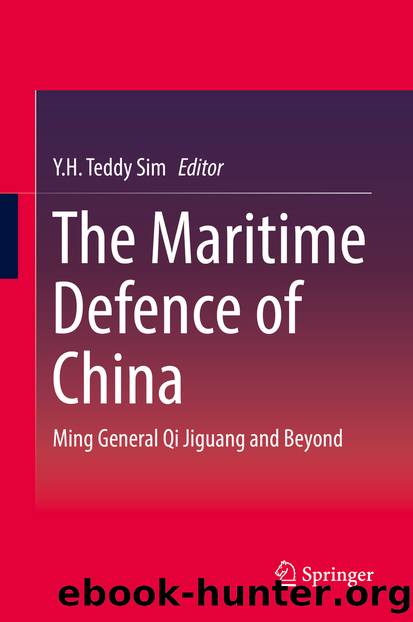The Maritime Defence of China by Y.H. Teddy Sim

Author:Y.H. Teddy Sim
Language: eng
Format: epub
Publisher: Springer Singapore, Singapore
8.4 Analysis of Skirmishes and Clashes
From the presentation of the fighting prowess of the contenders, it appears that both sidesâ capabilities were âevenly matchedââalthough, generally speaking, the Portuguese did not come in a grand expedition of conquest on this occasion. It might be of interest to note that during the 16th and early 17th centuries, occasional proposals were put forth to recommend the conquest of Chinaâalthough these were not implemented to any great extent.19 Despite the apparent decay that had occurred in the Ming military, some scholars have pointed out that the Portuguese were âimpressed by Chinaâs military powerâ.20
Luso-Chinese interactions in the early years of 1500 led to two clashes of arms between the two powers. The nephew of Afonso Albuquerque sent what was described by some scholars as the âfirst European maritime expedition to the Middle Kingdomâ in 1514.21 All that is known (and described by Barros) of the mission is that âJorge Alvares, the ambassador, left a padrão [on an] island in the Pearl River estuaryâ, although Chang Tien Tse quotes from the more optimistic Italian accounts that Alvares succeeded in exchanging goods at a great profit.22 A retinue of Lopo Soares de Albergaria with three captains was appointed in 1515 by King Manuel to âproceed to China to negotiate trading arrangementsâ.23 When Simão Pires de Andrade (the younger brother of Fernão Pires de Andrade) arrived in 1519 at Tunmen, at the estuary, he committed a number of actsâon top of his brotherâs offensive cannon-firing salute at Canton and the Portuguese conquest of Melakaâthat further infuriated the Chinese and negatively impacted Sino-Portuguese relations. Among the deeply offending gestures was Simão Andradeâs attempt to build a fort at Tunmen (with âimpressed Chinese labour gangsâ),24 obstructing merchants from other states such as Siam and Cambodia from carrying out their trade (until the Portuguese had done so) and buying Chinese children as slaves.
As a result of the deteriorating relations between the Portuguese and Chinese, Tomé Piresâ trip to Peking in 1521 was futile.25 The Europeans in Canton and Tunmen were ordered to leave China, and the Portuguese vessels had to âfight their way out of [Pearl River]â.26 According to Fernão Lopes de Castanhedaâs História do descobrimento (e conquista da India pelos Portugueses), the Portuguese representation to the Ming Chinese continued to be plagued by petitions from the Melaka court in exile (succeeding the court in Johor) to punish the Portuguese. Piresâ mission also encountered a series of communication issues that contributed to its failure. It appears that despite Simão Andradeâs transgression in 1519, the Portuguese remained at Tunmen and continued their activities there for another 2 or 3 years.27
Castanhedaâs História provides further details of the first and second battles of Tunmen. The Chinese squadron pursuing the Portuguese in the first skirmish at Tunmen was pegged at 50. This corresponds to the naval strength stipulated for the weisuo unit supposedly stationed in the area. Many Portuguese, and presumably quite a few vessels, must have been captured by the Chinese. The Chinese stripped the captured vessels of anything of use.
Download
This site does not store any files on its server. We only index and link to content provided by other sites. Please contact the content providers to delete copyright contents if any and email us, we'll remove relevant links or contents immediately.
| Automotive | Engineering |
| Transportation |
Whiskies Galore by Ian Buxton(41878)
Introduction to Aircraft Design (Cambridge Aerospace Series) by John P. Fielding(33064)
Small Unmanned Fixed-wing Aircraft Design by Andrew J. Keane Andras Sobester James P. Scanlan & András Sóbester & James P. Scanlan(32743)
Craft Beer for the Homebrewer by Michael Agnew(18140)
Turbulence by E. J. Noyes(7935)
The Complete Stick Figure Physics Tutorials by Allen Sarah(7307)
Kaplan MCAT General Chemistry Review by Kaplan(6866)
The Thirst by Nesbo Jo(6826)
Bad Blood by John Carreyrou(6552)
Modelling of Convective Heat and Mass Transfer in Rotating Flows by Igor V. Shevchuk(6391)
Learning SQL by Alan Beaulieu(6209)
Weapons of Math Destruction by Cathy O'Neil(6142)
Man-made Catastrophes and Risk Information Concealment by Dmitry Chernov & Didier Sornette(5921)
Digital Minimalism by Cal Newport;(5663)
Life 3.0: Being Human in the Age of Artificial Intelligence by Tegmark Max(5474)
iGen by Jean M. Twenge(5366)
Secrets of Antigravity Propulsion: Tesla, UFOs, and Classified Aerospace Technology by Ph.D. Paul A. Laviolette(5309)
Design of Trajectory Optimization Approach for Space Maneuver Vehicle Skip Entry Problems by Runqi Chai & Al Savvaris & Antonios Tsourdos & Senchun Chai(5011)
Pale Blue Dot by Carl Sagan(4909)
